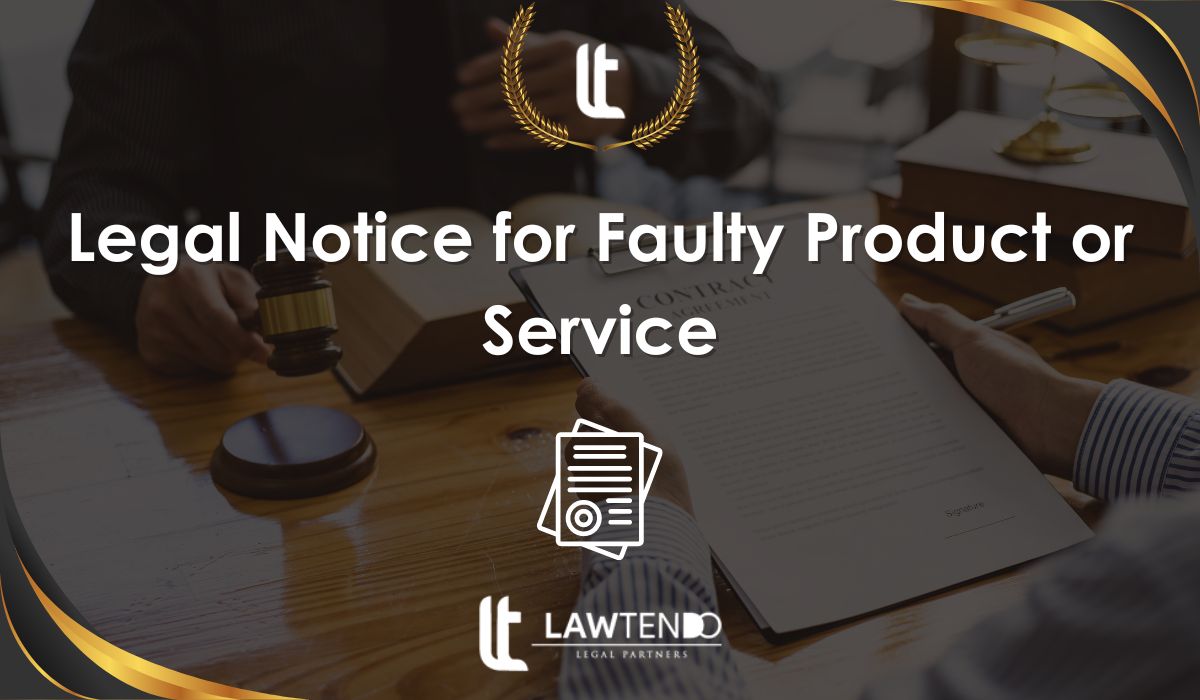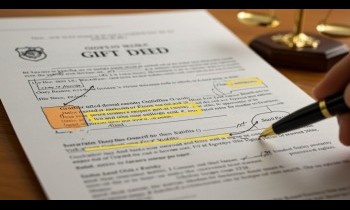Legal Notice for Faulty Product or Service

Date : 14 Mar, 2024
Post By admin
Written By : Advocate BAIJAYANTI Roy | 09 years of experience | ★★★★★
In the realm of consumer rights and business accountability, the issuance of a legal notice in response to a faulty product or service stands as a pivotal step towards seeking resolution. This formal communication, meticulously outlining grievances and demanding corrective measures, serves as a beacon of accountability. However, the intricacies involved in crafting such notices and the subsequent actions required are often underestimated. A well-structured legal notice not only signals intent but also lays the groundwork for potential legal recourse. As we navigate the landscape of legal redressal for faulty products or services, understanding the nuances of this process becomes paramount for effective communication and seeking restitution.
Understanding Your Rights
Understanding your rights when dealing with a faulty product or service is crucial for navigating the legal landscape, especially concerning Legal Notice Drafting. The Consumer Protection Act provides a framework to safeguard consumers encountering issues with purchased products or services.
Key Rights:
-
Consumer Complaints: If you receive a defective product, you have the right to file a consumer complaint and seek redress under the Consumer Protection Act.
-
Product Liability: Manufacturers and sellers are legally responsible for faulty products through product liability. Consumers can take legal action against these parties for placing defective products in their hands.
-
Strict Product Liability: Understand the concept of strict product liability, which holds manufacturers accountable for defective products regardless of negligence.
-
Implied Warranties: Implied warranties ensure products meet basic standards of quality and performance, protecting consumers' interests.
Legal Notice Drafting:
When drafting a legal notice for a faulty product, adhere to the required legal notice format to effectively communicate your grievances and potentially initiate a product liability claim.
Staying Informed:
Stay informed about consumer alerts and exercise your rights to protect yourself when encountering defective products or services.
Understanding these rights empowers consumers to take appropriate actions and seek remedies when faced with faulty products or services, ensuring fair treatment and redress under the law.
Assessing the Fault
When evaluating the fault in a product or service, a meticulous examination of the specific issue and its implications is crucial for determining potential legal recourse. Understanding the nuances of the fault can significantly impact the outcome of any legal proceedings. Here are some key points to consider:
- Identification of the Issue:
- Analyze the nature of the product/service defect.
- Determine how the fault has affected the consumer and if it breaches any consumer protection laws.
- Assessment of Liability:
- Evaluate who is responsible for the fault – the manufacturer, retailer, or another party.
- Consider if there are grounds for a legal complaint based on the severity of the fault and its consequences.
In cases where the fault leads to damages, consulting a lawyer specializing in product liability can provide valuable insights into building a strong case. By thoroughly assessing the fault in the product or service, you can better navigate the legal complexities and seek appropriate remedies through the court system.
Gathering Evidence
To build a compelling case for addressing a faulty product or service, meticulous collection of relevant evidence is essential. Gathering evidence plays a crucial role in supporting product liability claims and taking necessary action against the responsible party.
Key Steps:
-
Documentation: Collect all pertinent information, including receipts, contracts, warranties, and communication with the company regarding the issue.
-
Visual Evidence: Photographs or videos demonstrating the fault in the product or service can serve as valuable evidence in a potential defective product lawsuit.
-
Supporting Documentation: In cases of strict liability rules or implied warranty violations, having a robust collection of evidence can strengthen the consumer protection claim.
-
Testimonies: Gathering testimonies from witnesses or experts who can attest to the product's faultiness or inadequate service provided can further support the case.
Benefits of Evidence Collection:
By meticulously gathering evidence, individuals can enhance their chances of successfully addressing a faulty product or service through a legal notice. Strong evidence substantiates claims and increases the likelihood of obtaining a favorable outcome in resolving the issue.
A comprehensive collection of evidence forms the foundation of a compelling case, enabling individuals to assert their rights effectively and seek appropriate remedies for the harm caused by defective products or services.
Identifying the Responsible Party
In the process of addressing a faulty product or service through legal means, the crucial step of identifying the responsible party is paramount for pursuing appropriate recourse. When determining the responsible party for a faulty product or service, consider the following:
- Manufacturer Responsibility:
- Check if the manufacturer is liable for defects under product liability laws.
- Review warranties provided by the manufacturer to understand the extent of their responsibility.
- Claims and Lawsuit Consideration:
- Assess the possibility of filing a lawsuit against the manufacturer for compensation.
- Evaluate the claims process to understand the steps required to seek recourse for the faulty product or service.
Drafting the Legal Notice
The meticulous composition of a legal notice for a faulty product or service demands precision and expertise to effectively communicate grievances and expectations. When drafting the legal notice, it is crucial to adhere to the specific format and language required by the law. The legal notice should clearly state the issue with the product or service, mention any relevant laws or acts that have been violated, and outline the desired resolution. It is essential to address the notice to the responsible person or entity, ensuring that they understand the seriousness of the situation.
In the business world, timely action is key. Therefore, the legal notice should specify a reasonable timeframe for the recipient to respond or take corrective action. Additionally, if the faulty product or service is subject to any registration or certification requirements, it is important to highlight this in the notice. By following the correct procedures and including all necessary details in the legal notice, individuals can protect their rights and seek appropriate redress for any harm caused by defective products or services.
Including Key Information
When detailing key information within a legal notice for a faulty product or service, precision in articulating the specifics of the issue and desired outcomes is paramount. Key information to include in a legal notice regarding a faulty product or service encompasses:
- Product or Service Details:
- Clearly state the name, model, and any relevant identification numbers of the product or service in question.
- Provide a brief description of the fault or issue encountered and its impact on the consumer.
- Desired Resolutions:
- Specify the desired outcome, whether it involves a refund, replacement, repair, or compensation for damages incurred.
- Include a reasonable timeframe for the resolution to occur and indicate the consequences if the matter is not addressed promptly.
Sending the Notice
Detailing key information within the legal notice for a faulty product or service sets the foundation for the precision required in sending the notice promptly and effectively. When sending a legal notice regarding a defective product, it is crucial to ensure that the notice is addressed to the appropriate party, typically the seller or manufacturer responsible for the faulty item. The notice should clearly outline the issues experienced with the product, citing relevant laws governing product liability and implied warranties.
In cases of product liability, the legal notice serves as a formal communication informing the seller of their liability for the defective product. It may also mention the possibility of seeking compensatory damages for any harm caused by the faulty item. By sending the notice promptly and articulately, the recipient is made aware of the intention to pursue monetary damages or initiate a liability lawsuit if necessary.
Ultimately, the effectiveness of the legal notice can significantly impact the outcome of any potential civil suit related to the defective product, making the process of sending the notice a crucial step in resolving product-related disputes.
Follow-Up Actions
Upon sending the legal notice for a faulty product or service, consider strategically planning follow-up actions to ensure timely resolution and effective communication. It is crucial to take proactive steps to protect your rights and seek a remedy for the issue at hand. Here are some recommended follow-up actions:
- Engage in Direct Communication:
- Contact the company directly through various channels such as phone, email, or in-person visits to expedite the resolution process.
- Seek Legal Assistance:
- If the matter escalates or the company is unresponsive, consult with a lawyer specializing in product liability to understand your options, including potential legal proceedings.
Seeking Legal Advice
After engaging in direct communication and exploring potential options for legal recourse, seeking legal advice from a qualified attorney specializing in product liability can provide valuable insight and guidance on the next steps to take in addressing the faulty product or service issue. In product liability cases, understanding the nuances of consumer alerts, product liability laws, implied warranty of fitness, strict liability, and personal injury is crucial. A skilled attorney can assess the situation, determine the best course of action, and offer advice on drafting a legal notice that highlights the issue effectively. They can also provide clarity on the legal implications surrounding the faulty product or service, including any potential debt or compensation for injuries sustained. By seeking legal advice, individuals can navigate the complexities of product liability cases with confidence, ensuring that their rights are protected and that they receive the appropriate legal support to address the matter effectively.
Resolving the Dispute
To effectively resolve the dispute regarding a faulty product or service, a structured approach involving clear communication and documentation is essential. When handling such situations, it is crucial to follow these steps:
- Communication and Documentation:
- Open communication channels with the seller or service provider to address the issue promptly.
- Keep records of all conversations, receipts, warranties, and any other relevant documentation related to the purchase.
- Legal Recourse Options:
- Consider seeking legal advice to understand your rights and options, such as filing a product liability lawsuit.
- Be aware of consumer alerts and laws like lemon laws that protect consumers against defective products.
Conclusion
In conclusion, the process of addressing faulty products or services through a legal notice is a crucial step in seeking redressal and holding responsible parties accountable. By following the outlined steps, individuals can effectively communicate their grievances, demand corrective action, and potentially resolve disputes in a timely and efficient manner. Seeking legal advice when necessary can further enhance the chances of a favorable outcome in such situations.
Frequently Asked Questions
Q1. Can I Seek Compensation for Emotional Distress Caused by a Faulty Product or Service?
Ans. Yes, compensation for emotional distress due to a faulty product or service can be sought under certain circumstances. Proving the link between the fault and emotional distress is crucial. Legal expertise is recommended for drafting a compelling claim.
Q2. What Is the Deadline for Sending a Legal Notice for a Faulty Product or Service?
Ans. When considering the deadline for sending a legal notice for a faulty product or service, it is crucial to adhere to the specific timeframes outlined by relevant laws. Seek legal guidance promptly to ensure compliance and protect your rights.
Q3. Is It Necessary to Consult a Lawyer Before Drafting a Legal Notice for a Faulty Product or Service?
Ans. Consulting a lawyer before drafting a legal notice for a faulty product or service is advisable. Legal expertise ensures the notice is comprehensive, addresses relevant legal aspects, and increases the likelihood of a successful resolution.
Q4. Can I Still Pursue Legal Action if the Responsible Party Denies Liability in Response to the Legal Notice?
Ans. Yes, legal action can still be pursued if the responsible party denies liability in response to the legal notice. Consult with a lawyer to explore further legal options, gather evidence, and assess the strength of your case.
Q5. What Are the Potential Consequences for the Responsible Party if They Do Not Respond to the Legal Notice for a Faulty Product or Service?
Ans. Failure to respond to a legal notice for a faulty product or service can result in the responsible party facing escalated legal action. This may include lawsuits, penalties, fines, or even damage to their reputation. It is crucial to address legal notices promptly and appropriately.





